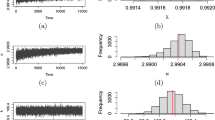Abstract
A general approach to Bayesian isotonic changepoint problems is developed. Such isotonic changepoint analysis includes trends and other constraint problems and it captures linear, non-smooth as well as abrupt changes. Desired marginal posterior densities are obtained using a Markov chain Monte Carlo method. The methodology is exemplified using one simulated and two real data examples, where it is shown that our proposed Bayesian approach captures the qualitative conclusion about the shape of the trend change.
Similar content being viewed by others
References
Bhattacharya P.K. (1994). Some aspects of change-point analysis. In: Carlstein E., Müller H., Siegmund D. (eds) Change-point problems. Institute of Mathematical Statistics, Hayward, CA, pp 28–56
Carlin B.P., GelfandA.E., Smith A.F.M. (1992). Hierarchical Bayesian analysis of changepoint problems. Applied Statistics 2: 389–405
Chernoff H., Zacks S. (1964). Estimating the current mean of a normal distribution which is subject to changes in time. Annals of Mathematical Statistics 35: 999–1018
Dey D.K., Purkayastha S. (1997). Bayesian approach to change-point problems. Communications in Statistics, Theory and Methods 26: 2035–2047
Gelfand A.E., Smith A.F., Lee T.M. (1992). Bayesian analysis of constrained parameter and truncated data problems using gibbs sampling. Journal of the American Statistical Association 87(418): 523–532
Fomby T.B., Vogelsang T.J. (2002). The application of size-robust trend statistics to global-warming temperature series. Journal of Climate 15(1): 117–123
Hinkley, D. V., Chapman, P., Rungel, G. (1980). Changepoint problems, Technical Report 382. University of Minessota, Minneapolis, MN.
Robertson T., Wright F.T., Dyskra R.L. (1988). Order restricted statistical inference. Wiley, New York
Shiryayev A.N. (1963). On optimum methods in quickest detection problems. Theory of Probability and its Applications 8: 22–46
Siegmund D. (1986). Boundary crossing probabilities and classical applications. Annals of Statistics 14: 361–404
Smith A.F.M. (1975). A Bayesian approach to inference about a change point in a sequence of random variables. Biometrika 62: 407–416
Wu W.B., Woodroofe M., Mentz G.B. (2001). Isotonic regression: another look at the change-point problem. Biometrika 88: 793–804
Zacks, S. (1983). Survey of classical and Bayesian approaches to the changepoint problem: fixed sample and sequential procedures or testing and estimation. In Recent advances in Statistics, Herman Chernoff Festschrift, (pp. 245–269). New York: Academic.
Author information
Authors and Affiliations
Corresponding author
About this article
Cite this article
Alvarez, E.E., Dey, D.K. Bayesian isotonic changepoint analysis. Ann Inst Stat Math 61, 355–370 (2009). https://doi.org/10.1007/s10463-007-0148-y
Received:
Revised:
Published:
Issue Date:
DOI: https://doi.org/10.1007/s10463-007-0148-y




